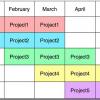|
Mining Scrum: Modeling the Earth One Iteration at a Time Scrum Tapped for Mining Industry Mankind has, and always will try to understand its environment. In the last century, radar technology has allowed individuals to track vehicles, ships, planes, and even space shuttles and stars. With advances in sonar, people now have the ability to imagine a journey to space, or explore the mysteries of the sea. With the right scientific equipment, scientists can even witness new life and see it evolve. In the mining industry, the ability to identify and assess the world of solids is paramount. |
||
|
An Agile Approach to Retail: A Data-Intrinsic Development Case Study Agile software development challenges traditional software development approaches. Rapidly changing environments characterized by evolving requirements and tight schedules require software developers to take an agile approach. These methods include practices such as short iterations, frequent releases, simple and emerging design, peer review, and on-site customer participation. |
||
|
What's More Important: Being Agile or Creating Value? In this video, Jonathan Kohl looks at why and for whom we develop software, what our end users and team members value, and the difference between tools and processes that create value and those that distract from it. |
||
|
Performing the Software: Succeeding at Agile Development Sometimes, it's helpful to explore how people in other occupations create their products in order for us to better our own. In addition to being an experienced software tester, Chris McMahon has spent time on the road and in the studio as a professional musician. In this article, Chris takes a look at some of the things that make for a successful live concert and compares them to what it takes for an agile team to build software successfully. |
||
 |
No: Such a Difficult Word When people begin to get overworked, it's common to fall back on blaming the old chestnut "time management." But the problem may have less to do with how you allocate time to projects than your inability to say no to some of those projects in the first place. In this article, Johanna Rothman takes a look at the difficulty of saying no and offers some suggestions for overcoming it. |
|
|
Tips and Advice - Continuous Integration
Podcast
Tips and Advice - Continuous Integration |
||
|
How Agile Practices Reduce Requirements Risks Requirements risks are among the most insidious risks threatening software projects. Whether it is having unclear requirements, lack of customer involvement in requirements development, or defective requirements, these troubles are a major culprit in projects that go awry. As requirements expert and agile coach Ellen Gottesdiener explains, agile practice can go a long way in mitigating those risks. |
||
|
Agile 2009 - Conference preview with Johanna Rothman
Podcast
Bob Payne chats with Johanna Rothman about the upcoming Agile 2009 conference. |
||
 |
Beauty Is in the Eye of the Beholder As a user experience design specialist, clients often ask Jeff Patton to make their software "look better," so it can be successful. But when clients focus primarily on aesthetics, they're often addressing the wrong thing. In this column, Jeff takes a look at common user interface (UI) mistakes and the key concerns software development teams should address to build successful UIs. |
|
|
How Scrum Generates Increased Productivity, Part Three: The Team An agile team is, of course, made up of a group of people. As such, it's unique in that responsibilities are distributed among multiple parties to successfully deliver a product increment. Just as the entire Scrum team (i.e. the ScrumMaster, Product Owner, and team) must depend upon one another to complete projects, so, too, the development team's members must trust each other to self-organize their way to success. |
Pages
Upcoming Events
| Apr 28 |
STAREAST Software Testing Conference in Orlando & Online |
| Jun 02 |
AI Con USA Bridging Minds and Machines |
| Sep 22 |
STARWEST Software Testing Conference in Anaheim & Online |
| Oct 13 |
Agile + DevOps USA The Conference for Agile and DevOps Professionals |










